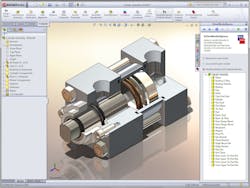The full digital manufacturing revolution — where everything from production lines to the components of the product being assembled on them are first optimized to the fullest in the virtual realm before production even begins — has, obviously, not yet been adopted by most manufacturers. The days of leveraging an integrated suite of CAD (computer aided design), PLM (product lifecycle management) and digital manufacturing software to streamline production and product management from beginning to end of product life are still some years off.
But the first ingredient in this futuristic manufacturing stew — CAD — has now been so widely adopted that the focus for users of the software is no longer just about a given CAD software package’s functionality, but how well it works in conjunction with other CAD systems.
This new reality of a multi-CAD environment has grown out of three key factors driving manufacturing economics:
• More manufacturers now partner with other companies to create a supply chain that delivers products or services based on each partnering company’s core competencies (fewer companies now deliver all the components in any given product);
• These partners are often geographically dispersed; and
• Consolidation of disparate manufacturing operations by a parent company through acquisition.
The result of any or all of these factors now commonplace in manufacturing means that many, if not most, products today are developed in a multi-CAD environment.
When dealing with a multi-CAD issue, many companies fall back on a strategy of purchasing licenses for all the necessary CAD suites, and performing data translation between the different solutions, according to the “CAD Selection Considerations: Multi-CAD Management” report from CIMData. From a pure cost perspective, that approach comes with the burdensome requirement of dealing with multiple solution providers, additional training, and maintaining and validating each new software release, the report states.
The answer to this issue, according to CIMData is to purchase CAD software that can smoothly import foreign CAD data. Beyond importing the CAD data, the new CAD software must also provide a “rich set of functions to manipulate and edit the imported geometry.”
To help aid in the selection of suitable CAD software for a use in a multi-CAD environment, CIMData suggests those involved with the new CAD purchase ask the following questions about the potential CAD software packages they are considering:
• Does the CAD suite allow for the smooth import of all the third-party CAD data formats our company must accept?
• Does the CAD suite allow for the smooth import of all legacy CAD data formats our company must access?
• Once third-party and legacy CAD data is imported, can our designers manipulate and edit individual geometry items within the data?
• Can the CAD solution handle foreign data’s design intent through feature recognition of form features and patterns?
• Once features and patterns are recognized, can the CAD solution handle edits to those geometric structures, especially those requiring topological change?
• Do the future goals of the CAD software provider align with company aspirations for such capabilities as real-time updates to geometry in a multi-user environment?
Leaders relevant to this article:


